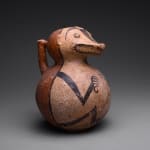Cocle Terracotta Vessel in the Form of a Coatimundi, 1200 CE - 1500 CE
Terracotta
height 21 cm
height 8 1/4 in
height 8 1/4 in
PF.1350
Further images
Archaeological excavations in the Cocle Province located in Central Panama have revealed that an ancient civilization once inhabited these lands. The findings suggested that the so-called Cocle culture arose around...
Archaeological excavations in the Cocle Province located in Central Panama have revealed that an ancient civilization once inhabited these lands. The findings suggested that the so-called Cocle culture arose around 500 A.D. and lasted until about 1000 A.D. Although their dating is roughly contemporaneous with the Diquis culture to the north in modern day Costa Rica, the art they left behind suggests that they were a unique, independent civilization. Cocle art, which consists primarily of unslipped or buff slipped pottery and terracotta sculptures, is distinguished by their polychrome hues and lively asymmetrical motifs which often include animal themes.
Cocle art reflects a deep love of the natural world. The flora and fauna of the region are depicted with a bold abstraction that combines a sense of wonder with a sense of humor. Here, through a blending of modeling and painting, a coatimundi emerges from the rounded contours of a vessel. Resembling a racoon, the coati is native to the Americas. It has a long tail which is usually held erect, something the potter has alluded to in the handle. Rendered with a few simple lines, this caoti bares his teeth and shows his sharp claws, as if to frighten away animal intruders from the contents of his jar. Try as he might, it is difficult for us to take him seriously. His charm far outweighs his ferocity.
Cocle art reflects a deep love of the natural world. The flora and fauna of the region are depicted with a bold abstraction that combines a sense of wonder with a sense of humor. Here, through a blending of modeling and painting, a coatimundi emerges from the rounded contours of a vessel. Resembling a racoon, the coati is native to the Americas. It has a long tail which is usually held erect, something the potter has alluded to in the handle. Rendered with a few simple lines, this caoti bares his teeth and shows his sharp claws, as if to frighten away animal intruders from the contents of his jar. Try as he might, it is difficult for us to take him seriously. His charm far outweighs his ferocity.









